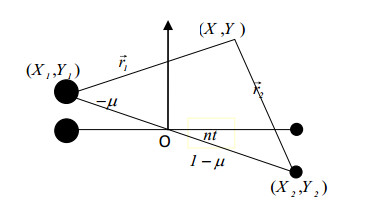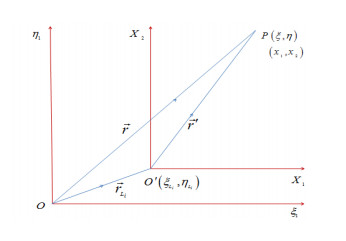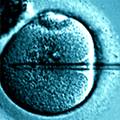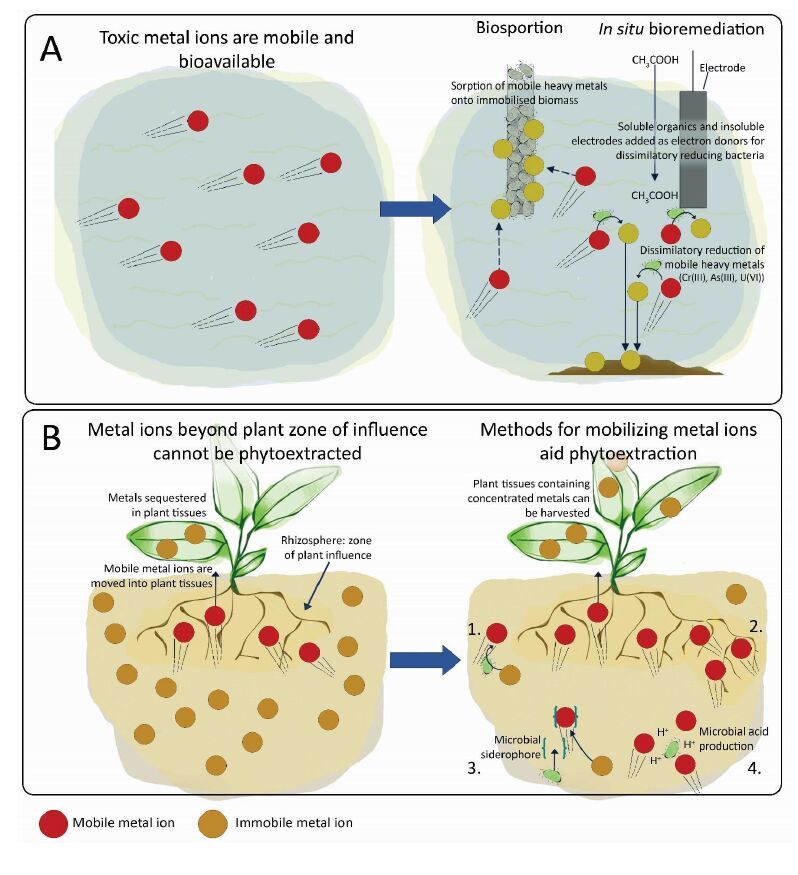|
[1]
|
Lum AF, Ngwa ESA, Chikoye D, et al. (2014) phytoremediation potential of weeds in heavy metal contaminated soils of the Bassa industrial zone of Douala, Cameroon. Int J Phytoremediation 16: 302–319.
|
|
[2]
|
Rajkumar M, Prasad MNV, Freitas H, et al. (2009) Biotechnological applications of serpentine soil bacteria for phytoremediation of trace metals. Crit Rev Biotechnol 29: 120–130.
|
|
[3]
|
Dalcorso G, Manara A, Furini A (2013) An overview of heavy metal challenge in plants: From roots to shoots. Metallomics 5: 1117–1132.
|
|
[4]
|
Liu H, Probst A, Liao B (2005) Metal contamination of soils and crops affected by the Chenzhou lead/zinc mine spill (Hunan, China). Sci Total Environ 339: 153–166.
|
|
[5]
|
Wasi S, Tabrez S, Ahmad M (2013) Toxicological effects of major environmental pollutants: An overview. Environ Monit Assess 185: 2585–2593.
|
|
[6]
|
Nagajyoti PC, Lee KD, Sreekanth TVM (2010) Heavy metals, occurrence and toxicity for plants: A review. Environ Chem Lett 8: 199–216.
|
|
[7]
|
Lebeau T, Braud A, Jézéquel K (2008) Performance of bioaugmentation-assisted phytoextraction applied to metal contaminated soils: A review. Environ Pollut 153: 497–522.
|
|
[8]
|
Agency for Toxic Substances and Disease Registry (2015) Priority List of Hazardous Substances. Atlanta: Agency for Toxic Substances and Disease Registry
|
|
[9]
|
Clemens S (2006) Toxic metal accumulation, responses to exposure and mechanisms of tolerance in plants. Biochimie 88: 1707–1719.
|
|
[10]
|
Järup L (2003) Hazards of heavy metal contamination. Br Med Bull 68: 167–182.
|
|
[11]
|
Tongesayi T, Fedick P, Lechner L, et al. (2013) Daily bioaccessible levels of selected essential but toxic heavy metals from the consumption of non-dietary food sources. Food Chem Toxicol 62: 142–147.
|
|
[12]
|
Khan S, Shahnaz M, Jehan N, et al. (2013) Drinking water quality and human health risk in Charsadda district, Pakistan. J Clean Prod 60: 93–101.
|
|
[13]
|
Martin R, Dowling K (2013) Trace metal contamination of mineral spring water in an historical mining area in regional Victoria, Australia. J Asian Earth Sc 77: 262–267.
|
|
[14]
|
Salt D E, Smith RD, Raskin I (1998) Phytoremediation. Annu Rev Plant Physiol Plant Mol Biol 49: 643–668.
|
|
[15]
|
Rascio N, Navari-Izzo F (2011) Heavy metal hyperaccumulating plants: How and why do they do it? And what makes them so interesting? Plant Sci 180: 169–181.
|
|
[16]
|
Anderson CWN, Brooks RR, Chiarucci A, et al. (1999) Phytomining for nickel, thallium and gold. J Geochem Explor 67: 407–415.
|
|
[17]
|
Robinson BH, Brooks RR, Gregg PEH, et al. (1999) The nickel phytoextraction potential of some ultramafic soils as determined by sequential extraction. Geoderma 87: 293–304.
|
|
[18]
|
Sheoran V, Sheoran AS, Poonia P (2011) Role of hyperaccumulators in phytoextraction of metals from contaminated mining sites: A review. Crit Rev Environ Sci Technol 41: 168–214.
|
|
[19]
|
Alford ÉR, Pilon-Smits EAH, Paschke MW (2010) Metallophytes-a view from the rhizosphere. Plant Soil 337: 33–50.
|
|
[20]
|
Finneran KT, Anderson RT, Nevin KP, et al. (2002) Potential for Bioremediation of Uranium-Contaminated Aquifers with Microbial U(VI) Reduction. Soil Sediment Contam 11: 339–357.
|
|
[21]
|
Gadd GM (2009) Biosorption: Critical review of scientific rationale, environmental importance and significance for pollution treatment. J Chem Technol Biotechnol 84: 13–28.
|
|
[22]
|
Aracic S, Manna S, Petrovski S, et al. (2015) Innovative biological approaches for monitoring and improving water quality. Front Microbiol 6: 826.
|
|
[23]
|
Das N, Vimala R, Karthika P (2008) Biosorption of heavy metals - An overview. Indian J Biotechnol 7: 159–169.
|
|
[24]
|
Vijayaraghavan K, Yun YS (2008) Bacterial biosorbents and biosorption. Biotechnol Adv 26: 266–291.
|
|
[25]
|
Ahluwalia SS, Goyal D (2007) Microbial and plant derived biomass for removal of heavy metals from wastewater. Bioresour Technol 98: 2243–2257.
|
|
[26]
|
Aryal M, Liakopoulou-Kyriakides M (2015) Bioremoval of heavy metals by bacterial biomass. Environ Monit Assess 187: 4173.
|
|
[27]
|
Gadd GM (2004) Microbial influence on metal mobility and application for bioremediation. Geoderma 122: 109–119.
|
|
[28]
|
Lovley DR, Holmes DE, Nevin KP (2004) Dissimilatory Fe(III) and Mn(IV) reduction. Adv Microb Physiol 49: 219–286.
|
|
[29]
|
Bolan N, Kunhikrishnan A, Gibbs J (2013) Rhizoreduction of arsenate and chromate in Australian native grass, shrub and tree vegetation. Plant Soil 367: 615–625.
|
|
[30]
|
Kashefi K, Lovley DR (2000) Reduction of Fe(III), Mn(IV), and toxic metals at 100°C by Pyrobaculum islandicum. Appl Environ Microbiol 66: 1050–1056.
|
|
[31]
|
Williams KH, N'Guessan A, Druhan J, et al. (2010) Electrodic voltages accompanying stimulated bioremediation of a uranium-contaminated aquifer. J Geophys Res (G Biogeosci) 115.
|
|
[32]
|
Zhuang K, Ma E, Lovley DR, et al. (2012) The design of long-term effective uranium bioremediation strategy using a community metabolic model. Biotechnol Bioeng 109: 2475–2483.
|
|
[33]
|
Anderson RT, Vrionis HA, Ortiz-Bernad I, et al. (2003) Stimulating the In Situ Activity of Geobacter Species to Remove Uranium from the Groundwater of a Uranium-Contaminated Aquifer. Appl Environ Microbiol 69: 5884–5891.
|
|
[34]
|
Gadd GM (2010) Metals, minerals and microbes: Geomicrobiology and bioremediation. Microbiology 156: 609–643.
|
|
[35]
|
N'Guessan AL, Vrionis HA, Resch CT, et al. (2008) Sustained removal of uranium from contaminated groundwater following stimulation of dissimilatory metal reduction. Environ Sci Technol 42: 2999–3004.
|
|
[36]
|
Finneran KT, Housewright ME, Lovley DR (2002) Multiple influences of nitrate on uranium solubility during bioremediation of uranium-contaminated subsurface sediments. Environ Microbiol 4: 510–516.
|
|
[37]
|
Sheoran V, Sheoran AS, Poonia P (2016) Factors affecting phytoextraction: A review. Pedosphere 26: 148–166.
|
|
[38]
|
Ernst WHO (1996) Bioavailability of heavy metals and decontamination of soils by plants. Appl Geochem 11: 163–167.
|
|
[39]
|
Blaylock MJ, Salt DE, Dushenkov S, et al. (1997) Enhanced accumulation of Pb in Indian mustard by soil-applied chelating agents. Environ Sci Technol 31: 860–865.
|
|
[40]
|
Cooper EM, Sims JT, Cunningham SD, et al. (1999) Chelate-assisted phytoextraction of lead from contaminated soils. J Environ Qual 28: 1709–1719.
|
|
[41]
|
Tandy S, Bossart K, Mueller R, et al. (2004) Extraction of heavy metals from soils using biodegradable chelating agents. Environ Sci Technol 38: 937–944.
|
|
[42]
|
Mulligan CN (2005) Environmental applications for biosurfactants. Environ Pollut 133: 183–198.
|
|
[43]
|
Freitas EV, Nascimento C (2016) Degradability of natural and synthetic chelating agents applied to a lead-contaminated soil. J Soils Sed 1–7.
|
|
[44]
|
Liu D, Islam E, Li T, et al. (2008) Comparison of synthetic chelators and low molecular weight organic acids in enhancing phytoextraction of heavy metals by two ecotypes of Sedum alfredii Hance. J Hazard Mater 153: 114–122.
|
|
[45]
|
Karimzadeh L, Heilmeier H, Merkel BJ (2012) Effect of microbial siderophore DFO-B on Cd accumulation by Thlaspi caerulescens hyperaccumulator in the presence of zeolite. Chemosphere 88: 683–687.
|
|
[46]
|
Gunawardana B, Singhal N, Johnson A (2011) Effects of amendments on copper, cadmium, and lead phytoextraction by Lolium perenne from multiple-metal contaminated solution. Int J Phytoremediation 13: 215–232.
|
|
[47]
|
Angle JS, Linacre NA (2005) Metal phytoextraction - A survey of potential risks. Int J Phytoremediation 7: 241–254.
|
|
[48]
|
Bolan N, Kunhikrishnan A, Thangarajan R, et al. (2014) Remediation of heavy metal(loid)s contaminated soils - To mobilize or to immobilize? J Hazard Mater 266: 141–166.
|
|
[49]
|
Robinson BH, Chiarucci A, Brooks RR, et al. (1997) The nickel hyperaccumulator plant Alyssum bertolonii as a potential agent for phytoremediation and phytomining of nickel. J Geochem Explor 59: 75–86.
|
|
[50]
|
Dell'Amico E, Cavalca L, Andreoni V (2008) Improvement of Brassica napus growth under cadmium stress by cadmium-resistant rhizobacteria. Soil Biol Biochem 40: 74–84.
|
|
[51]
|
Hernlem BJ, Vane LM, Sayles GD (1996) Stability constants for complexes of the siderophore desferrioxamine b with selected heavy metal cations. Inorg Chim Acta 244: 179–184.
|
|
[52]
|
Neilands JB (1995) Siderophores: Structure and function of microbial iron transport compounds. J Biol Chem 270: 26723–26726.
|
|
[53]
|
Kim JO, Lee YW, Chung J (2013) The role of organic acids in the mobilization of heavy metals from soil. KSCE J Civ Eng 17: 1596–1602.
|
|
[54]
|
Li WC, Ye ZH, Wong MH (2010) Metal mobilization and production of short-chain organic acids by rhizosphere bacteria associated with a Cd/Zn hyperaccumulating plant, Sedum alfredii. Plant Soil 326: 453–467.
|
|
[55]
|
Abhilash PC, Powell JR, Singh HB, et al. (2012) Plant-microbe interactions: Novel applications for exploitation in multipurpose remediation technologies. Trends Biotechnol 30: 416–420.
|
|
[56]
|
Sessitsch A, Kuffner M, Kidd P, et al. (2013) The role of plant-associated bacteria in the mobilization and phytoextraction of trace elements in contaminated soils. Soil Biol Biochem 60: 182–194.
|
|
[57]
|
Glick BR (2010) Using soil bacteria to facilitate phytoremediation. Biotechnol Adv 28: 367–374.
|
|
[58]
|
Lugtenberg B, Kamilova F (2009) Plant-growth-promoting rhizobacteria. Annu Rev Microbiol 63: 541–556.
|
|
[59]
|
Rajkumar M, Ae N, Prasad MNV, et al. (2010) Potential of siderophore-producing bacteria for improving heavy metal phytoextraction. Trends Biotechnol 28: 142–149.
|
|
[60]
|
Hayat R, Ali S, Amara U, et al. (2010) Soil beneficial bacteria and their role in plant growth promotion: A review. Ann Microbiol 60: 579–598.
|
|
[61]
|
Badri DV, Weir TL, van der Lelie D, et al. (2009) Rhizosphere chemical dialogues: plant-microbe interactions. Curr Opin Biotechnol 20: 642–650.
|
|
[62]
|
Onofre-Lemus J, Hernández-Lucas I, Girard L, et al. (2009) ACC (1-aminocyclopropane-1-carboxylate) deaminase activity, a widespread trait in Burkholderia species, and its growth-promoting effect on tomato plants. Appl Environ Microbiol 75: 6581–6590.
|
|
[63]
|
De Souza MP, Huang CPA, Chee N, et al. (1999) Rhizosphere bacteria enhance the accumulation of selenium and mercury in wetland plants. Planta 209: 259–263.
|
|
[64]
|
Malekzadeh E, Alikhani HA, Savaghebi-Firoozabadi GR, et al. (2012) Bioremediation of cadmium-contaminated soil through cultivation of maize inoculated with plant growth-promoting rhizobacteria. Bioremediation J 16: 204–211.
|
|
[65]
|
Abou-Shanab RA, Angle JS, Delorme TA, et al. (2003) Rhizobacterial effects on nickel extraction from soil and uptake by Alyssum murale. New Phytol 158: 219–224.
|
|
[66]
|
Abou-Shanab RI, Delorme TA, Angle JS, et al. (2003) Phenotypic Characterization of Microbes in the Rhizosphere of Alyssum murale. Int J Phytoremediation 5: 367–379.
|
|
[67]
|
Amprayn KO, Rose MT, Kecskés M, et al. (2012) Plant growth promoting characteristics of soil yeast (Candida tropicalis HY) and its effectiveness for promoting rice growth. Appl Soil Ecol 61: 295–299.
|
|
[68]
|
Whiting SN, De Souza MP, Terry N (2001) Rhizosphere bacteria mobilize Zn for hyperaccumulation by Thlaspi caerulescens. Environ Sci Technol 35: 3144–3150.
|
|
[69]
|
Lodewyckx C, Mergeay M, Vangronsveld J, et al. (2002) Isolation, characterization, and identification of bacteria associated with the zinc hyperaccumulator Thlaspi caerulescens subsp. calaminaria. Int J Phytoremediation 4: 101–115.
|
|
[70]
|
Park JH, Bolan N, Megharaj M, et al. (2011) Isolation of phosphate solubilizing bacteria and their potential for lead immobilization in soil. J Hazard Mater 185: 829–836.
|
|
[71]
|
Zhang YF, He LY, Chen ZJ, et al. (2011) Characterization of ACC deaminase-producing endophytic bacteria isolated from copper-tolerant plants and their potential in promoting the growth and copper accumulation of Brassica napus. Chemosphere 83: 57–62.
|
|
[72]
|
Zhang S, Reddy MS, Kloepper JW (2004) Tobacco growth enhancement and blue mold disease protection by rhizobacteria: relationship between plant growth promotion and systemic disease protection by PGPR strain 90–166. Plant Soil 262: 277–288.
|
|
[73]
|
Shahzad SM, Arif MS, Riaz M, et al. (2013) PGPR with varied ACC-deaminase activity induced different growth and yield response in maize (Zea mays L.) under fertilized conditions. Eur J Soil Biol 57: 27–34.
|
|
[74]
|
Wakelin SA, Warren RA, Ryder MH (2004) Effect of soil properties on growth promotion of wheat by Penicillium radicum. Aust J Soil Res 42: 897–904.
|
|
[75]
|
Kamnev AA, Tugarova AV, Antonyuk LP, et al. (2005) Effects of heavy metals on plant-associated rhizobacteria: Comparison of endophytic and non-endophytic strains of Azospirillum brasilense. J Trace Elem Med Bio 19: 91–95.
|
|
[76]
|
Latour X, Philippot L, Corberand T, et al. (1999) The establishment of an introduced community of fluorescent pseudomonads in the soil and in the rhizosphere is affected by the soil type. FEMS Microbiol Ecol 30: 163–170.
|
|
[77]
|
Melent'ev AI, Kuz'mina LY, Galimzyanova NF (2000) Effect of temperature and soil moisture content on the colonization of the wheat rhizosphere by antiphytopathogenic bacilli. Microbiology 69: 351–356.
|
|
[78]
|
Gerhardt KE, Huang XD, Glick BR, et al. (2009) Phytoremediation and rhizoremediation of organic soil contaminants: Potential and challenges. Plant Sci 176: 20–30.
|
|
[79]
|
Kang Y, Shen M, Wang H, et al. (2013) A possible mechanism of action of plant growth-promoting rhizobacteria (PGPR) strain Bacillus pumilus WP8 via regulation of soil bacterial community structure. J Gen Appl Microbiol 59: 267–277.
|
|
[80]
|
Abou-Shanab RAI, Angle JS, Chaney RL (2006) Bacterial inoculants affecting nickel uptake by Alyssum murale from low, moderate and high Ni soils. Soil Biol Biochem 38: 2882–2889.
|
|
[81]
|
Abou-Shanab RA, Ghanem K, Ghanem N, et al. (2008) The role of bacteria on heavy-metal extraction and uptake by plants growing on multi-metal-contaminated soils. World J Microbiol Biotechnol 24: 253–262.
|
|
[82]
|
Belimov AA, Kunakova AM, Safronova VI, et al. (2004) Employment of rhizobacteria for the inoculation of barley plants cultivated in soil contaminated with lead and cadmium. Microbiology 73: 99–106.
|
|
[83]
|
Gao Y, Miao C, Mao L, et al. (2010) Improvement of phytoextraction and antioxidative defense in Solanum nigrum L. under cadmium stress by application of cadmium-resistant strain and citric acid. J Hazard Mater 181: 771–777.
|
|
[84]
|
He LY, Chen ZJ, Ren GD, et al. (2009) Increased cadmium and lead uptake of a cadmium hyperaccumulator tomato by cadmium-resistant bacteria. Ecotoxicol Environ Saf 72: 1343–1348.
|
|
[85]
|
Lampis S, Santi C, Ciurli A, et al. (2015) Promotion of arsenic phytoextraction efficiency in the fern Pteris vittata by the inoculation of As-resistant bacteria: A soil bioremediation perspective. Front Plant Sci 6: 80.
|
|
[86]
|
Li WC, Ye ZH, Wong MH (2007) Effects of bacteria on enhanced metal uptake of the Cd/Zn-hyperaccumulating plant, Sedum alfredii. J Exp Bot 58: 4173–4182.
|
|
[87]
|
Liu W, Wang Q, Wang B, et al. (2015) Plant growth-promoting rhizobacteria enhance the growth and Cd uptake of Sedum plumbizincicola in a Cd-contaminated soil. J Soils Sed 1–9.
|
|
[88]
|
Ma Y, Rajkumar M, Freitas H (2009) Improvement of plant growth and nickel uptake by nickel resistant-plant-growth promoting bacteria. J Hazard Mater 166: 1154–1161.
|
|
[89]
|
Ma Y, Rajkumar M, Freitas H (2009) Inoculation of plant growth promoting bacterium Achromobacter xylosoxidans strain Ax10 for the improvement of copper phytoextraction by Brassica juncea. J Environ Manage 90: 831–837.
|
|
[90]
|
Ma Y, Rajkumar M, Luo Y, et al. (2011) Inoculation of endophytic bacteria on host and non-host plants-Effects on plant growth and Ni uptake. J Hazard Mater 195: 230–237.
|
|
[91]
|
Ma Y, Rajkumar M, Luo Y, et al. (2013) Phytoextraction of heavy metal polluted soils using Sedum plumbizincicola inoculated with metal mobilizing Phyllobacterium myrsinacearum RC6b. Chemosphere 93: 1386–1392.
|
|
[92]
|
Płociniczak T, Sinkkonen A, Romantschuk M, et al. (2013) Characterization of Enterobacter intermedius MH8b and its use for the enhancement of heavy metals uptake by Sinapis alba L. Appl Soil Ecol 63: 1–7.
|
|
[93]
|
Prapagdee B, Chanprasert M, Mongkolsuk S (2013) Bioaugmentation with cadmium-resistant plant growth-promoting rhizobacteria to assist cadmium phytoextraction by Helianthus annuus. Chemosphere 92: 659–666.
|
|
[94]
|
Rajkumar M, Freitas H (2008) Influence of metal resistant-plant growth-promoting bacteria on the growth of Ricinus communis in soil contaminated with heavy metals. Chemosphere 71: 834–842.
|
|
[95]
|
Rajkumar M, Ma Y, Freitas H (2013) Improvement of Ni phytostabilization by inoculation of Ni resistant Bacillus megaterium SR28C. J Environ Manage 128: 973–980.
|
|
[96]
|
Rani A, Souche Y, Goel R (2013) Comparative in situ remediation potential of Pseudomonas putida 710A and Commamonas aquatica 710B using plant (Vigna radiata (L.) wilczek) assay. Ann Microbiol 63: 923–928.
|
|
[97]
|
Sheng X, He L, Wang Q, et al. (2008) Effects of inoculation of biosurfactant-producing Bacillus sp. J119 on plant growth and cadmium uptake in a cadmium-amended soil. J Hazard Mater 155: 17–22.
|
|
[98]
|
Yang Q, Tu S, Wang G, et al. (2012) Effectiveness of applying arsenate reducing bacteria to enhance arsenic removal from polluted soils by Pteris vittata L. Int J Phytoremediation 14: 89–99.
|
|
[99]
|
Zaidi S, Usmani S, Singh BR, et al. (2006) Significance of Bacillus subtilis strain SJ-101 as a bioinoculant for concurrent plant growth promotion and nickel accumulation in Brassica juncea. Chemosphere 64: 991–997.
|
|
[100]
|
Zhang X, Lin L, Chen M, et al. (2012) A nonpathogenic Fusarium oxysporum strain enhances phytoextraction of heavy metals by the hyperaccumulator Sedum alfredii Hance. J Hazard Mater 229–230: 361–370.
|
|
[101]
|
Muehe EM, Weigold P, Adaktylou IJ, et al. (2015) Rhizosphere microbial community composition affects cadmium and zinc uptake by the metal-hyperaccumulating plant Arabidopsis halleri. Appl Environ Microbiol 81: 2173–2181.
|
|
[102]
|
Muehe EM, Obst M, Hitchcock A, et al. (2013) Fate of Cd during microbial Fe(III) mineral reduction by a novel and Cd-tolerant geobacter species. Environ Sci Technol 47: 14099–14109.
|
|
[103]
|
Rodríguez H, Fraga R (1999) Phosphate solubilizing bacteria and their role in plant growth promotion. Biotechnol Adv 17: 319–339.
|
|
[104]
|
Ma Y, Prasad MNV, Rajkumar M, et al. (2011) Plant growth promoting rhizobacteria and endophytes accelerate phytoremediation of metalliferous soils. Biotechnol Adv 29: 248–258.
|
|
[105]
|
Spaepen S, Vanderleyden J, Remans R (2007) Indole-3-acetic acid in microbial and microorganism-plant signaling. FEMS Microbiol Rev 31: 425–448.
|
|
[106]
|
Ryu RJ, Patten CL (2008) Aromatic amino acid-dependent expression of indole-3-pyruvate decarboxylase is regulated by tyrr in Enterobacter cloacae UW5. J Bacteriol 190: 7200–7208.
|
|
[107]
|
Sharma SB, Sayyed RZ, Trivedi MH, et al. (2013) Phosphate solubilizing microbes: Sustainable approach for managing phosphorus deficiency in agricultural soils. SpringerPlus 2:
|
|
[108]
|
Mattey M (1992) The production of organic acids. Crit Rev Biotechnol 12: 87–132.
|
|
[109]
|
Thijs S, Sillen W, Rineau F, et al. (2016) Towards an Enhanced Understanding of Plant–Microbiome Interactions to Improve Phytoremediation: Engineering the Metaorganism. Front Microbiol 7: 341.
|
|
[110]
|
Siciliano SD, Fortin N, Mihoc A, et al. (2001) Selection of Specific Endophytic Bacterial Genotypes by Plants in Response to Soil Contamination. Appl Environ Microbiol 67: 2469–2475.
|
|
[111]
|
Hamamura N, Olson SH, Ward DM, et al. (2006) Microbial population dynamics associated with crude-oil biodegradation in diverse soils. Appl Environ Microbiol 72: 6316–6324.
|
|
[112]
|
Edgar RC (2010) Search and clustering orders of magnitude faster than BLAST. Bioinformatics 26: 2460–2461.
|
|
[113]
|
Caporaso JG, Kuczynski J, Stombaugh J, et al. (2010) QIIME allows analysis of high-throughput community sequencing data. Nat Methods 7: 335–336.
|
|
[114]
|
Cole JR, Wang Q, Fish JA, et al. (2014) Ribosomal Database Project: Data and tools for high throughput rRNA analysis. Nucleic Acids Res 42: D633–D642.
|
|
[115]
|
Howe AC, Jansson JK, Malfatti SA, et al. (2014) Tackling soil diversity with the assembly of large, complex metagenomes. Proc Natl Acad Sci USA 111: 4904–4909.
|
|
[116]
|
Langille MGI, Zaneveld J, Caporaso JG, et al. (2013) Predictive functional profiling of microbial communities using 16S rRNA marker gene sequences. Nat Biotechnol 31: 814–821.
|
|
[117]
|
Aßhauer KP, Wemheuer B, Daniel R, et al. (2015) Tax4Fun: Predicting functional profiles from metagenomic 16S rRNA data. Bioinformatics 31: 2882–2884.
|
|
[118]
|
Tu Q, Yu H, He Z, et al. (2014) GeoChip 4: A functional gene-array-based high-throughput environmental technology for microbial community analysis. Mol Ecol Resour 14: 914–928.
|
|
[119]
|
Andrews SC, Robinson AK, Rodríguez-Quiñones F (2003) Bacterial iron homeostasis. FEMS Microbiol Rev 27: 215–237.
|










 DownLoad:
DownLoad:




